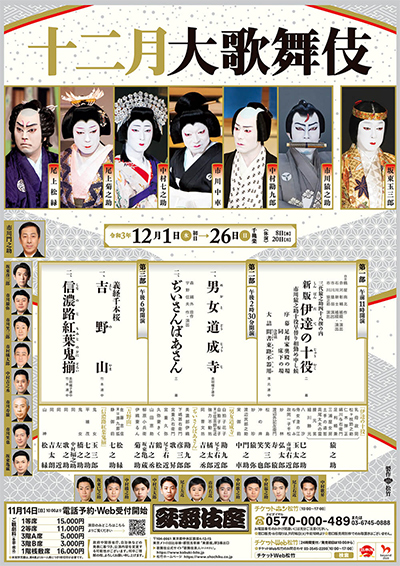| Comments |
The traditional kaomise in Ky˘to at the Minamiza.
Sarashi Sanbas˘: at the Hakone Gongen Shrine at the foot of Mt. Hakone, a commotion is caused by the loss of the treasured
white banner belonging to the Genji clan that had been dedicated to the shrine.
Two women appear and, claiming it is also in dedication to the shrine, they start dancing a sanbas˘ dance.
When a piece of cloth drops out of one of the women's pocket, they are accused of stealing the
white Genji banner. In fact, they are princesses related to the Heike clan, and they
stole the banner to curse their arch-rival, the Genji clan. In dance form, they swing the white banner
above their heads as though it was a long strip of cloth being bleached in the sun (nuno-zarashi).
Featuring young actors Nakamura Kazutar˘, Nakamura Takanosuke and Nakamura Toranosuke.
Sonezaki Shinjű: a young merchant named Hiranoya Tokubŕ has long been in
love with the courtesan Tenmaya Ohatsu and is diligently trying to buy out her contract.
But he is swindled out of his money by someone he considered a friend.
Then he is beaten and humiliated in the precincts of the Ikutama Shrine.
He sneaks into the teahouse where Ohatsu is and she hides him under the veranda.
At this point, Tokubŕ's "friend" comes and calls him a criminal.
Ohatsu fiercely defends Tokubŕ and asks whether he is prepared to defend his
honor by committing love suicide. Silently, from under the veranda,
he holds her bare foot and draws it across his neck. The journey to the forest
where they commit love suicide is like a dream, half-way between this world
and the next and has some of the most famous lines in Japanese theatre:
"Farewell to this world and to this night, farewell. To what should we who go
to our deaths be likened? We are like the frost on the road leading to the
graveyard, vanishing with each step". Starring Nakamura Ganjir˘ and Nakamura Senjaku in
the roles of Tokubŕ and Ohatsu. Featuring also Nakamura Baigyoku and Nakamura Kikaku.
Sannin Kichisa:
(Three Thieves Named Kichisa)
The playwright Kawatake Mokuami excelled at portrayals of thieves and this short scene,
with its music and poetic lines, is one of his most famous.
A beautiful young woman helps out a woman who is lost on the road.
But she is actually Oj˘ Kichisa, a male thief who is disguised as a woman.
He steals an immense sum of money that the woman is carrying and this leads to
an encounter on this riverbank of three thieves, all with the name Kichisa.
The two others Kichisa are Osh˘ Kichisa, a bonze turned thief, and Ob˘ Kichisa, an ex-samurai turned thief
Though they start out as rivals, they decide to become blood brothers
and form a gang. Featuring Kataoka Takatar˘ as Oj˘ Kichisa, Nakamura Shikan as Osh˘ Kichisa and Nakamura Hayato as Ob˘ Kichisa.
Migawari Zazen: a dance play adopted from a classical ky˘gen farce.
A man (Living National Treasure Kataoka Nizaemon) wants nothing more than to visit his lover Hanako,
but he has one important problem, his homely and overbearing wife (Nakamura Shikan).
He creates a scheme saying that he will be practicing Zen meditation all night
and has his servant (Nakamura Hayato) take his place while he visits Hanako.
He returns, giddy from a night of pleasure and
tells his story to his servant in dance, unaware that his wife has discovered
his deception and has taken his servant's place.
Kari no Tayori: an unusual play in the ďsaka acting style originally written in the 19th century
by Nakamura Utaemon III. A barber (Matsumoto K˘shir˘) finds his feelings twisted one way and
another by the events in the neighboring samurai mansion where the lord is trying to force Tsukasa (Kataoka Senju), a beautiful woman,
to become his mistress. The play shows the barber's changing reactions to two letters from the beautiful
woman declaring her love for him. One letter is sincere, the other is a forgery but both turn out to be dangerous
traps. Featuring also Band˘ Takesabur˘, Kataoka Ainosuke, Nakamura Kinnosuke, Kamimura Kichiya and Kataoka Shinnosuke.
Kumo no Ito: one of the oldest dances related to the legend of a giant ground spider that
attacked the medieval warrior Minamoto no Yorimitsu. Yorimitsu
is visited by the spider with magical powers disguised first as a kosh˘, second as a taiko mochi,
third as a zat˘ and finally as a keisei.
After revealing its true nature, the spider spins trying to trap the warrior in its web. ACT plays the five roles of this hengemono.
Featuring Matsumoto K˘shir˘ as Minamoto no Yorimitsu.
Sources: Earphone Guide Website or Sh˘chiku Kabuki Official Website
|


